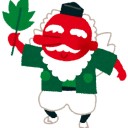神河当時 - 日本神話モチーフの課題
2020年8月12日 Magic: The Gathering
昨日の記事の続きです。
日本神話を選んだ後、様々な課題が見つかりました。
1 「神話」の意味合いが他国と異なる。ギリシャ神話や北欧神話の神々は現在ではだれも信じていないが、日本の神々は今も信仰されている。
2 多くの欧米人は、日本と言えば侍や忍者である。
3 多くの欧米人は、日本とその他アジアの文化を混同しがちである。
4 天狗、鬼、河童など、通常のマジックの色と役割に合わない。欧米人にとってなじみがない。
特に4については、天狗を例にしています。
外見は、長鼻の妖怪(赤のゴブリン)か鳥人(青白のエイヴン)
生息地は、森(緑)か山(赤)
こうした点をどのように工夫したのかは、この先でも触れられます。
仮に神河に再訪することがあったとしても、これらの課題は特に変わらないままです。別のアプローチでの解決を試みることがあるのでしょうか。
2021/03/09 追記
日本語訳を見つけました。
一連の幸運:神河世界のデザイン――神河の巨大な世界の創造
https://web.archive.org/web/20041113050558/http://www.hobbyjapan.co.jp/magic/articles/files/20041025_01.html
Respecting Japan
Over the next several days, I identified some challenges and problems with a Japanese-inspired setting. First and foremost, Japan doesn’t have a mythology per se, if by “mythology” you mean a pantheon of no-longer-worshipped gods. There’s folklore, of course, but all the “old gods” of Japan are still very much alive in Shinto and Buddhism. In other words, what would be considered mythology in the ancient Greek or Norse culture is current religious practice in Japanese culture.
Second, many Westerners just don’t know much about ancient and/or feudal Japan beyond samurai and ninja. Ask a typical American to name some elements of a Japanese-inspired fantasy setting, and they’ll name samurai, ninja, Eastern dragons, “honor,” maybe some medieval Japanese weapons . . . and that’s about it. And maybe they’ll throw in some random Chinese stuff, too.
Which brings me to the third problem: Many Westerners confuse Chinese or Korean cultural elements with Japanese, or worse, they don’t think the differences are significant. I felt very strongly that we shouldn’t do an Asian mishmash setting. To me, putting kung fu or Sun Tzu into a Japan-inspired setting is no different from creating a Babylonian-flavored setting and then populating it with Vikings.
The last major problem also derives from the second one: Magic is a game about creatures and spells, and yet most Westerners simply aren’t familiar with the creatures and magic of Japanese lore. Using words like “tengu,” “kappa,” “oni,” “shugendo,” and “onmyodo” will usually get you blank stares. And to make matters worse, the creatures of Japanese folklore are bizarre and complex, and many just won’t fit neatly into Magic’s five colors or its values.
Take tengu, for example, which are a major feature of Japanese folklore. Depending on what you read, they’re either long-nosed goblins or bird-men. They’re either honorable duelists or perverted tricksters. They’re forest dwellers, or maybe mountain dwellers. Now pick a color for these creatures. They’re sort of goblins, so they’re red. They’re bird-men, so they’re white or blue (like Aven). They’re forest dwellers, so they’re green. And in addition to all these complications, Westerners aren’t familiar with them anyway.
引用元
A SERIES OF FORTUNATE EVENTS: KAMIGAWA WORLD DESIGN Posted in Feature on October 18, 2004
https://magic.wizards.com/en/articles/archive/feature/series-fortunate-events-kamigawa-world-design-2004-10-18
日本神話を選んだ後、様々な課題が見つかりました。
1 「神話」の意味合いが他国と異なる。ギリシャ神話や北欧神話の神々は現在ではだれも信じていないが、日本の神々は今も信仰されている。
2 多くの欧米人は、日本と言えば侍や忍者である。
3 多くの欧米人は、日本とその他アジアの文化を混同しがちである。
4 天狗、鬼、河童など、通常のマジックの色と役割に合わない。欧米人にとってなじみがない。
特に4については、天狗を例にしています。
外見は、長鼻の妖怪(赤のゴブリン)か鳥人(青白のエイヴン)
生息地は、森(緑)か山(赤)
こうした点をどのように工夫したのかは、この先でも触れられます。
仮に神河に再訪することがあったとしても、これらの課題は特に変わらないままです。別のアプローチでの解決を試みることがあるのでしょうか。
2021/03/09 追記
日本語訳を見つけました。
一連の幸運:神河世界のデザイン――神河の巨大な世界の創造
https://web.archive.org/web/20041113050558/http://www.hobbyjapan.co.jp/magic/articles/files/20041025_01.html


コメント